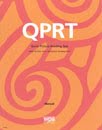
Quick Picture Reading Test qprt
For: Provides a quick estimate of reading ability that's relevant to real-world reading tasks
Reading Level: Ages 8 to 89 years
Format: Paper-and-Pencil
Length: 10 minutes or less
Scoring: Hand Scored
Authors
Amber M. Klein, Ph.D. and David S. Herzberg, Ph.D.
Description
In 10 minutes or less, this convenient screener gives you a reliable estimate of general reading ability. Its innovative item format requires examinees to match phrases and pictures, drawing on both word recognition and comprehension skills. This makes the QPRT relevant to a variety of real-world reading tasks. It’s more informative than a simple word recognition test, yet much quicker than a traditional reading comprehension measure.
Matching Phrases With Pictures
The QPRT is composed of 26 short phrases and 35 simple line drawings. The examinee reads each phrase, scans the drawings and chooses the image that best represents the meaning of the phrase.
Appropriate for ages 8 to 89 years, the test may be administered to individuals or groups. It offers two convenient AutoScore Test Forms-one for adults (ages 17 to 89 years) and one for children (ages 8 to 19 years). These forms are identical in item content and presentation, though different norms apply to each. They overlap in age so that users may choose the form that’s more appropriate for ages 17 to 19 years, who may be in either a school or work setting.
The QPRT has a 10-minute time limit, which is more than sufficient for most examinees. (The purpose of the time limit is simply to discourage respondents from prolonging the task.) Instructions to examinees are written at a third-grade reading level and printed directly on the test forms. Typically, administration and scoring may be handled by support personnel.
A Clear-Cut Reading Index Score
It takes only a couple of minutes to score the QPRT and obtain a Reading Index (which is a standard score). In addition, you may convert raw scores to percentile ranks and grade equivalents.
QPRT norms are based on a sample of 2,826 English-speaking individuals (1,203 adults and 1,876 children, with each group including approximately 270 late adolescents). For ages 7 to 12 years, norms are presented at 1-year intervals; for ages 13 to 16 years, at 2-year intervals; and for ages 17 to 19 years, in aggregate. For adults, normative data are grouped by decade. All groups except the oldest (ages 80 to 89 years) are composed of at least 100 individuals. In terms of gender, ethnicity, and socio-economic status, the standardisation sample represents the general U.S. population. Data from a diverse clinical sample of 480 adults and children are presented to demonstrate the criterion-related validity of the Reading Index Score.
A Useful Alternative to Longer Reading Tests
The QPRT may be used by various professionals, in numerous settings:
Academic: The QPRT engages children who are difficult to assess with longer, more conventional achievement tests.
Human Resources: The QPRT is an efficient way to screen job applicants for ability to read and understand written material such as technical manuals.
Clinical: The QPRT can help you determine a respondent’s reading level prior to administering self-report inventories or other psychological tests.
Research: The QPRT offers a quick way to qualify (or classify) research participants for studies that require reading.
In all of these situations the QPRT provides a useful alternative to longer reading tests. It’s quick; it spans a wide age range; it may be completed independently in just about any setting; and its items are more engaging than those on conventional reading tests. Because the QPRT draws on both word recognition and comprehension skills, it produces an estimate of reading ability that’s relevant to reading tasks encountered in the real world.
NB: Prices are in Australian dollars inclusive of GST. NZ customers need to log in to view ex-GST prices.



